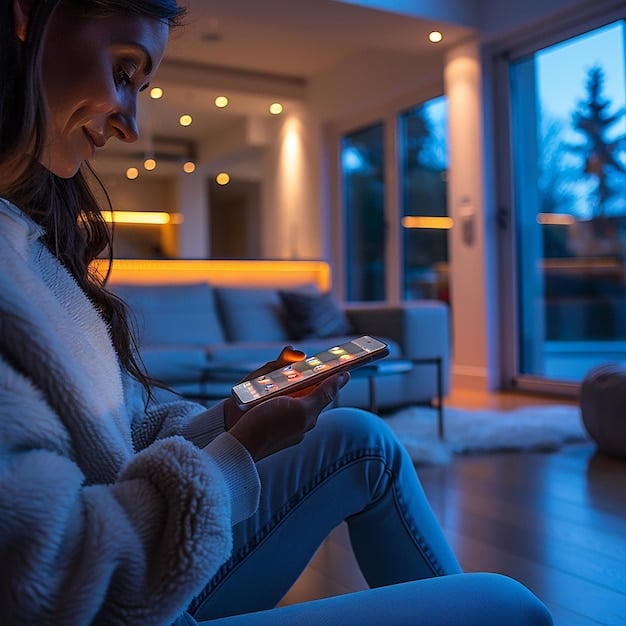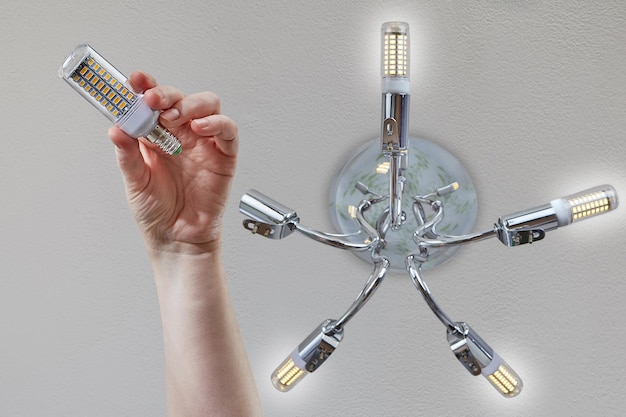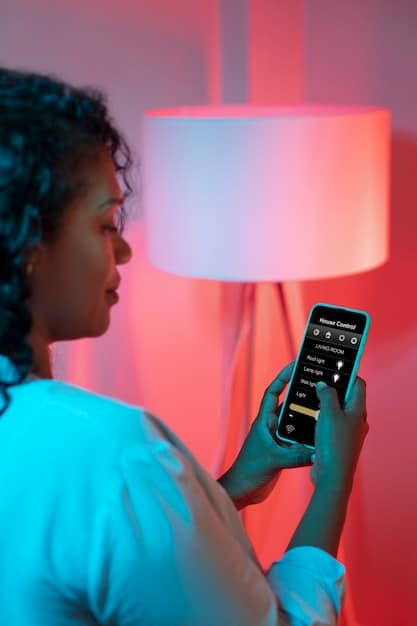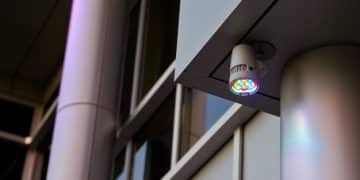How to Install Smart Home Lighting for a 15% Energy Saving in 2025

Anúncios
Installing smart home lighting in 2025 can help you save up to 15% on your energy bill by using energy-efficient bulbs and smart controls to optimise usage and reduce waste.
Ready to save money and energy? Discover how to install smart home lighting for a 15% energy saving in 2025 and transform your home into a smart, efficient space.
Anúncios
Understanding the Benefits of Smart Home Lighting
Smart home lighting systems offer numerous benefits, from energy savings to increased convenience and enhanced security. They allow homeowners to control their lighting remotely, automate schedules, and optimise energy consumption.
By understanding these advantages, you can make informed decisions about upgrading your home lighting.
Anúncios
Energy Efficiency and Cost Savings
One of the primary benefits of smart lighting is its potential for energy savings. Smart bulbs, particularly LEDs, consume significantly less energy than traditional incandescent bulbs. When combined with smart controls, you can minimise energy waste and reduce your electricity bill.
Convenience and Customisation
Smart lighting offers unparalleled convenience. You can control your lights from anywhere using a smartphone or voice assistant. You can also set custom schedules, dim lights to create different moods, and integrate lighting with other smart home devices.

- Remote Control: Adjust your lights from anywhere via a smartphone app.
- Automated Schedules: Set timers and schedules to automatically turn lights on and off.
- Voice Control: Use voice assistants like Alexa or Google Assistant to manage your lighting.
- Customisable Scenes: Create pre-set lighting scenes for different activities and moods.
In conclusion, smart home lighting improves energy efficiency through smart controls and LED bulbs. It also maximizes convinience through smart controls and customisation.
Planning Your Smart Lighting Installation
Before you start installing smart lighting, you need to create a solid plan. This involves assessing your current lighting setup, choosing the right smart lighting products, and understanding the compatibility between different devices.
A well-thought-out plan will ensure a smooth and successful installation process.
Assessing Your Current Lighting Setup
Start by evaluating your existing lighting fixtures and bulbs. Identify which areas of your home you want to upgrade and determine the types of bulbs and fixtures you need. Consider the brightness, colour temperature, and style of the lights.
Choosing the Right Smart Lighting Products
There are various smart lighting products available, including smart bulbs, switches, dimmers, and hubs. Research different brands and models to find the ones that best suit your needs and budget. Consider factors like compatibility, features, and user reviews.
- Smart Bulbs: Easy to install and offer a wide range of features, including dimming and colour changing.
- Smart Switches and Dimmers: Allow you to control existing fixtures without replacing the bulbs.
- Smart Hubs: Act as a central control point for your smart lighting system, connecting all your devices.
- Motion Sensors: Automatically turn lights on and off based on motion detection, saving energy.
When upgrading to smart lighting, ensure to create a detailed plan to assess your current lighting system. Do so by picking the products best tailored to fit your budget and lighting requirements.
Step-by-Step Installation Guide for Smart Bulbs
Installing smart bulbs is a straightforward process that most homeowners can handle themselves. Follow these step-by-step instructions to properly set up your smart bulbs and connect them to your smart home system.
By following these simple steps, you can enjoy the benefits of smart lighting in no time.
Preparing for Installation
Before you begin, gather all the necessary tools and materials. This includes your smart bulbs, a smartphone or tablet with the manufacturer’s app, and a stable Wi-Fi connection. Ensure that the power to the fixture is turned off at the circuit breaker.
Installing the Smart Bulbs
Unscrew the old bulb and replace it with the smart bulb. Make sure the bulb is securely screwed in. Turn the power back on at the circuit breaker and follow the instructions in the manufacturer’s app to connect the bulb to your Wi-Fi network.

- Download the App: Download the smart bulb’s app from the App Store or Google Play.
- Create an Account: Follow the app’s instructions to create an account.
- Connect to Wi-Fi: Connect the smart bulb to your home’s Wi-Fi network.
- Control and Customise: Use the app to control the bulb’s brightness, colour, and schedule.
Smart bulb installation requires you to prepare the necessary tools and switch off the power before installing them. Moreover, download the app to connect to Wi-Fi and other devices.
Setting Up Smart Switches and Dimmers
Smart switches and dimmers offer an alternative to smart bulbs, allowing you to control your existing fixtures. The installation process involves replacing your old switch with a smart one and connecting it to your smart home system.
Learn the different models and installation process of smart switches and dimmers below:
Choosing the Right Switch or Dimmer
Consider both the type of lights you want to control and the design you prefer. Smart switches typically work for a wider range of fixtures, while dimmers are best for creating a specific mood.
Installing the Switch or Dimmer
Turn the power off at the breaker, remove the faceplate, test the wiring, and disconnect the wires. Connect the wires to the new switch or dimmer as indicated in the manufacturer’s instructions. Secure the switch in the wall box and reattach the faceplate. Turn the power back on and test the switch.
- Safety First: Always turn off the power at the circuit breaker before working with electrical wiring.
- Follow Instructions: Carefully read and follow the manufacturer’s instructions for your specific switch or dimmer.
- Test the Connections: Ensure all wires are securely connected before turning the power back on.
Before implementing this, make sure to analyze the lights you plan to adjust and your desired design. After assessing this, then turn off power to your circuit breaker before replacing fixtures. This way, you can install smart swithches and dimmers safely.
Integrating Smart Lighting with Your Smart Home Ecosystem
To maximise the benefits of smart lighting, integrate it with your existing smart home ecosystem. This involves connecting your lighting system to other smart devices and setting up automations and routines.
Integrating smart lighting improves the overall functionality and convenience of your smart home.
Connecting to a Smart Hub
If you have a smart hub, such as Amazon Echo or Google Home, connect your smart lighting system to it. This will allow you to control your lights using voice commands and integrate them with other smart devices.
Creating Automations and Routines
Set up automations and routines to automate your lighting based on specific triggers. For example, you can set your lights to turn on automatically at sunset or when motion is detected in a particular area.
- Voice Control: Use voice commands to turn lights on and off, dim them, or change colours.
- IFTTT Integration: Use IFTTT (If This Then That) to create custom automations based on various triggers.
- Geofencing: Automatically turn lights on and off when you enter or leave your home.
Connecting smart lights enhances voice control with other smart devices improving convenience. This allows for integration of custom automations based on triggers for specific environments.
Troubleshooting Common Smart Lighting Issues
Despite its many benefits, smart lighting can sometimes encounter technical difficulties. This section addresses some common issues and provides solutions for troubleshooting them.
Find out the different problems that may come up when setting up your smart lightings below:
Connectivity Problems
If your smart bulbs or switches are not connecting to your Wi-Fi network, check your Wi-Fi router and ensure that it is functioning correctly. Restart the router and try reconnecting the devices. Also, make sure your smart devices are within range of the Wi-Fi signal.
Compatibility Issues
Some smart lighting products may not be compatible with certain smart hubs or other devices. Check the compatibility list before purchasing and ensure that all your devices are compatible with each other.
- Firmware Updates: Keep your smart lighting devices updated with the latest firmware to ensure optimal performance and compatibility.
- Factory Reset: If you are experiencing persistent issues, try performing a factory reset on your smart devices.
- Seek Support: Contact the manufacturer’s customer support for assistance if you are unable to resolve the issue yourself.
Troubleshooting can involve a variety of issues from connection to compatibility. To solve any issue, ensure that all devices are connected and compatible with each other.
| Key Point | Brief Description |
|---|---|
| 💡 Energy Savings | Reduce energy consumption by using smart LED bulbs and automated schedules. |
| 📱 Remote Control | Manage your lights from anywhere using a smartphone or voice assistant. |
| ⏰ Automated Schedules | Set timers and schedules for automatic lighting adjustments. |
| 🛠️ Easy Installation | Install smart bulbs and switches with simple, step-by-step instructions. |
Frequently Asked Questions
Smart lighting can help you save up to 15% on your energy bill by using energy-efficient bulbs and smart controls to optimise usage and reduce waste. This will cut down electricity bills considerably for the upcoming year.
Yes, smart bulbs are generally easy to install. Simply screw them into your existing light fixtures like traditional bulbs and follow the manufacturer’s instructions to connect them to your Wi-Fi network.
While some smart lighting systems require a smart hub, many smart bulbs can connect directly to your Wi-Fi network without one. However, a hub can enhance functionality and integration with other smart devices.
Yes, most smart lighting systems are compatible with voice assistants like Amazon Alexa and Google Assistant. You can use voice commands to turn lights on and off, dim them, or change colours.
Setting automated schedules can save energy by ensuring lights are only on when needed. It can also enhance security by making it appear as though someone is home, even when you are away.
Conclusion
Installing smart home lighting for a 15% energy saving in 2025 is a worthwhile investment! From energy savings, to convenience and added value, it’s hard not to consider upgrading your property. By following this simple guide, you’ll have created an energy-positive environment in no time.





